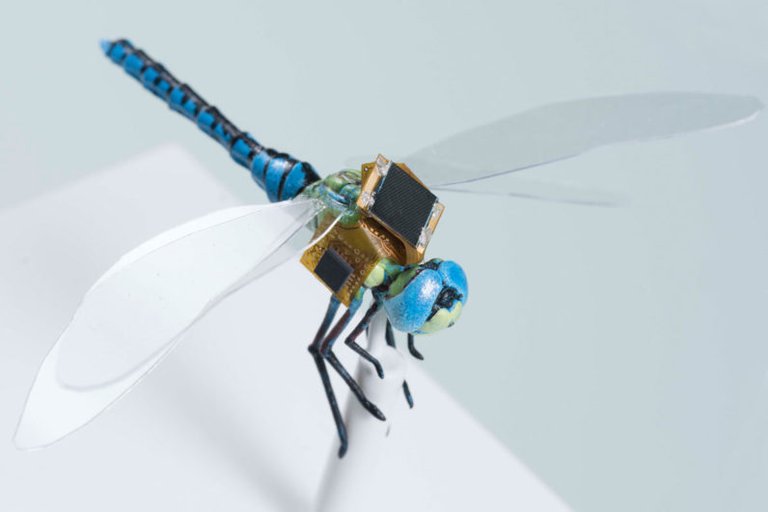Dragonfly Drone
Relatively, drones haven't been around for very long. It was in 2002 when the CIA first used an unmanned Predator drone in a targeted killing at Paktia province in Afghanistan. Since then the drone industry has evolved so fast that scientists at Charles Stark Draper Laboratory and Howard Hughes Medical Institute are now strapping backpacks on dragonflies to collect data - calling It DragonflEye.
Engineers at Draper are creating a new kind of hybrid drone by combining miniaturized navigation, synthetic biology and neurotechnology to guide dragonfly insects. The cyborgs are equipped with solar panels and are genetically modified with "steering neurons" in the insect's spinal cord. These steering neurons are so sensitive to light that when little, fiber-optic-like structures are placed in the dragonfly's eyes they send pulses of light to the brain. This allows the researchers to physically control the direction of the dragonfly.


What's the point?
So what's the point of kidnapping these harmless insects and turning them into cyborgs? In theory, the dragonfly will be manned by humans to collect data via its sensors from environments that aren't safe for humans. For example, we can use the DragonflEye for guided pollination, payload delivery, reconnaissance and even diagnostics. “DragonflEye is a totally new kind of micro-aerial vehicle that’s smaller, lighter and stealthier than anything else that’s manmade,” said Jesse J. Wheeler, a biomedical engineer at Draper and principal investigator on the program. “This system pushes the boundaries of energy harvesting, motion sensing, algorithms, miniaturization and optogenetics, all in a system small enough for an insect to wear.”
Does it hurt the dragonflies?
Yes and no. I mean, obviously getting plucked out of the sky and strapping on a backpack filled with electronics isn't going to feel good, but it does not mess with the sensors or muscles. Instead, optical electrodes inject steering commands directly into its nervous system, which has been tweaked to accept them. This means that the dragonfly can be controlled to fly where you want, without sacrificing the built-in flight skills that make insects the envy of all other robotic micro air vehicles.
DragonflEye provides opportunities to put technology on some of nature’s most agile insects. For instance, honeybees, whose population has dwindled by half in the last 25 years, could be equipped with Draper’s technology to assist with pollination. One of nature’s greatest pollinators, honeybees contribute more than $15 billion to the value of U.S. agriculture every year. Draper’s tiny guidance system could help stem the loss of pollinators by monitoring their flight patterns, migration, and overall health.
Can anyone guess the purpose of the solar panels? The right answer will receive an upvote by the techchat team.

Very cool, I want one, thanks for sharing!
interesting much - but I think technology can still learn a lot from how insects organize them self too #swarmintelligence
I totally agree. The reason a dragonfly inspired this technological advancement is that of how efficient and easy to maneuver they are.
Thought I’ve also heard of bees or beetles being manipulated by microchips before too somewhere on the WWW. Although it would be freakin awesome to control a dragonfly with my FrSky Taranis one day 😂
This is awesome, each day we're going to the future